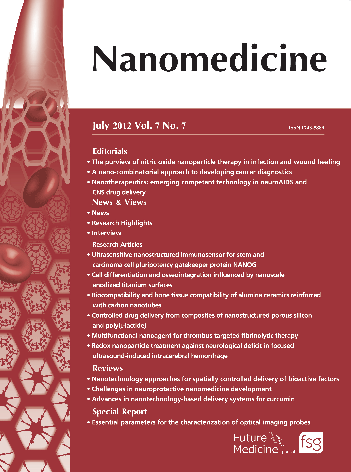Nanomedicine

https://www.futuremedicine.com/journal/nnm
ISSN (print): 1743-5889 | ISSN (online): 1748-6963
Frequency: 30 issues per year
Impact Factor: 5.5 (2022)
Medicine has developed throughout time but has remained forever concerned with the maintenance of health and thus the science of prevention and alleviation, and ultimately curing, of disease. To continue its development in new directions, medicine is now looking to nanomedicine, an emerging scientific specialty born from nanotechnology, which has grown up in the fields of engineering, physics, chemistry and biotechnology, and is now moving into medicine, with huge potential for expansion and development over the next decade and beyond.
As our knowledge of the human body continues to improve, nanotechnology will be developed to monitor, repair and control human biological systems at the molecular level. This will offer unique opportunities for developing new therapeutic approaches to diagnose, prevent, treat and eradicate life-threatening diseases and conditions (such as cancer and diabetes), as well as resolving pain and improving medical techniques (such as bone repair and surgical techniques), through various novel nanotechnological approaches.
Nanomedicine is a uniquely medicine-focused journal, addressing the important challenges and advances in medical nanoscale-structured material and devices, biotechnology devices and molecular machine systems and nanorobotics, delivering this essential information in concise, clear and attractive article formats. The journal is a valuable information source for all players in the field – academic, industrial and clinical researchers, pharmaceutical and biotechnology companies, regulatory authorities and others across the scientific community.
Coverage includes:
- Principles of nanomedicine, including basic research and theoretical applications
- Nanotechnological advances and their potential medical applications
- Disorders/conditions and the benefits of nanomedical tools versus traditional techniques
- Pre-clinical testing of novel nanomedical tools
- Diagnostic tools and applications
- Implanted nanodevices for the prevention and treatment of disease and the alleviation of pain
- Nanomedical tools in gene therapy for inherited diseases
- Tissue, cell and genetic engineering involving nanomedical tools
- Therapeutic applications of nanotechnology
- Drug delivery using nano-particles (natural and artificial) or devices
- Technologies already in clinical use: diagnostics, therapeutics or surgical aids
- Prediction of adverse reactions of nanomedical technology, toxicology and safety issues
- Ethical, regulatory and legal issues
- Commercialization, funding and economics of nanomedical technology
The nanomedicine field is still in its infancy, however, in the next few years there are likely to be further exciting developments across medical science, engineering, chemistry and physics. Diverse researchers working together under the nanomedicine umbrella will produce findings with potential medical uses: preventing, diagnosing and treating human diseases, as well as relieving pain. Nanomedicine will provide a critical overview of these advances as they unfold, helping to shape the future of medicine in this exciting era.